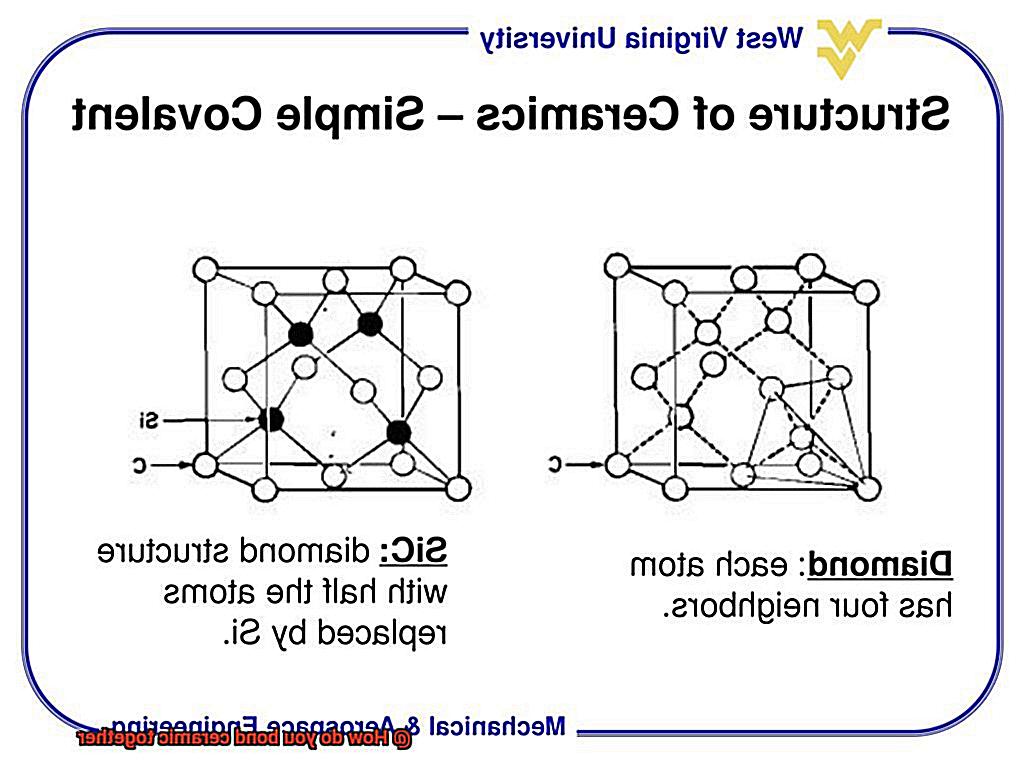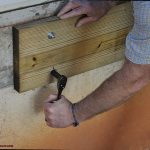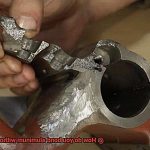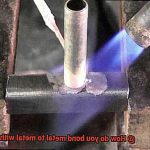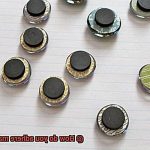Creating unbreakable connections between ceramic materials is an art form in itself. Traditional adhesives often leave us with fragile and brittle results, but fear not. There are specialized techniques that allow us to fuse ceramics together, creating bonds that defy the test of time.
Ceramics have impeccable heat and corrosion resistance, but their brittle nature poses a challenge when it comes to joining them. However, with innovative methods like ceramic welding, adhesive bonding, and mechanical fastening, we unlock a world of possibilities for using ceramics in diverse applications.
Whether you’re an artist crafting intricate ceramic sculptures or an engineer developing cutting-edge aerospace components, understanding and harnessing these bonding techniques will revolutionize the durability and reliability of your ceramic creations.
Join us as we dive into the fascinating world of ceramic bonding, exploring the intricacies of the process and its applications in various industries. From intricate repairs to the construction of advanced ceramics, this guide will equip you with the knowledge to forge robust connections that elevate your ceramic projects to new heights of excellence. So let’s get started on our journey towards unbreakable bonds.
Adhesives for Bonding Ceramic
Contents
- 1 Adhesives for Bonding Ceramic
- 1.1 Factors to Consider:
- 1.2 Common Types of Adhesives:
- 1.3 Epoxy Resin
- 1.4 Properties of Epoxy Resin:
- 1.5 Types of Epoxy Resins:
- 1.6 Cyanoacrylate Glue (Super Glue)
- 1.7 Composition:
- 1.8 Surface Preparation:
- 1.9 Application:
- 1.10 Curing Time:
- 1.11 Strength and Durability:
- 1.12 Limitations:
- 1.13 Ceramic-Specific Bonding Agents
- 2 Mechanical Fasteners for Bonding Ceramics
- 3 Factors that Affect the Success of Bonding Ceramics
- 4 Surface Preparation Before Applying Adhesives or Bonding Agents
- 5 Application Techniques for Different Adhesives and Bonding Agents
- 6 Tips for Choosing the Right Adhesive or Bonding Agent
- 7 Benefits of Using Mechanical Fasteners to Bond Ceramics
- 8 Conclusion
Selecting the right adhesive for bonding ceramic is crucial for achieving durable and robust bonds. With a variety of options available, it can be challenging to determine which adhesive is best suited for your specific needs. In this comprehensive guide, we will explore the factors to consider when selecting adhesives for bonding ceramic and discuss the different types of adhesives commonly used.
Factors to Consider:
Bond Strength:
Temperature Resistance:
Chemical Resistance:
Flexibility:
Surface Preparation:
- Ensure clean, dry, and contaminant-free surfaces.
- Enhance bond strength by roughening surfaces with sandpaper or using ceramic-specific primers.
Common Types of Adhesives:
Epoxy Adhesives:
- Exceptional strength and durability.
- Consist of two components that need to be mixed before application.
- Excellent resistance to heat, moisture, and chemicals.
Cyanoacrylate (Super Glue):
- Fast curing times and strong bonding strength.
- May have lower resistance to heat and chemicals compared to epoxy adhesives.
Silicone Adhesives:
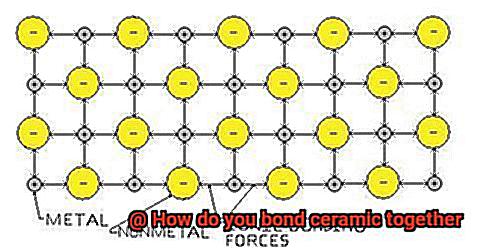
- Provides flexibility, making it suitable for applications requiring movement or vibrations.
- May not offer the same strength as epoxy or cyanoacrylate adhesives.
Polyurethane Adhesives:
- Outstanding bonding strength and impact resistance.
- Frequently used in industrial applications that demand high strength.
Application Tips:
- Proper surface preparation is crucial, including cleaning and roughening surfaces.
- Apply adhesive evenly on both surfaces and firmly press them together.
- Follow manufacturer’s instructions for curing time, which can vary depending on adhesive type.
- Test adhesive on a small, inconspicuous area before applying it to the entire surface.
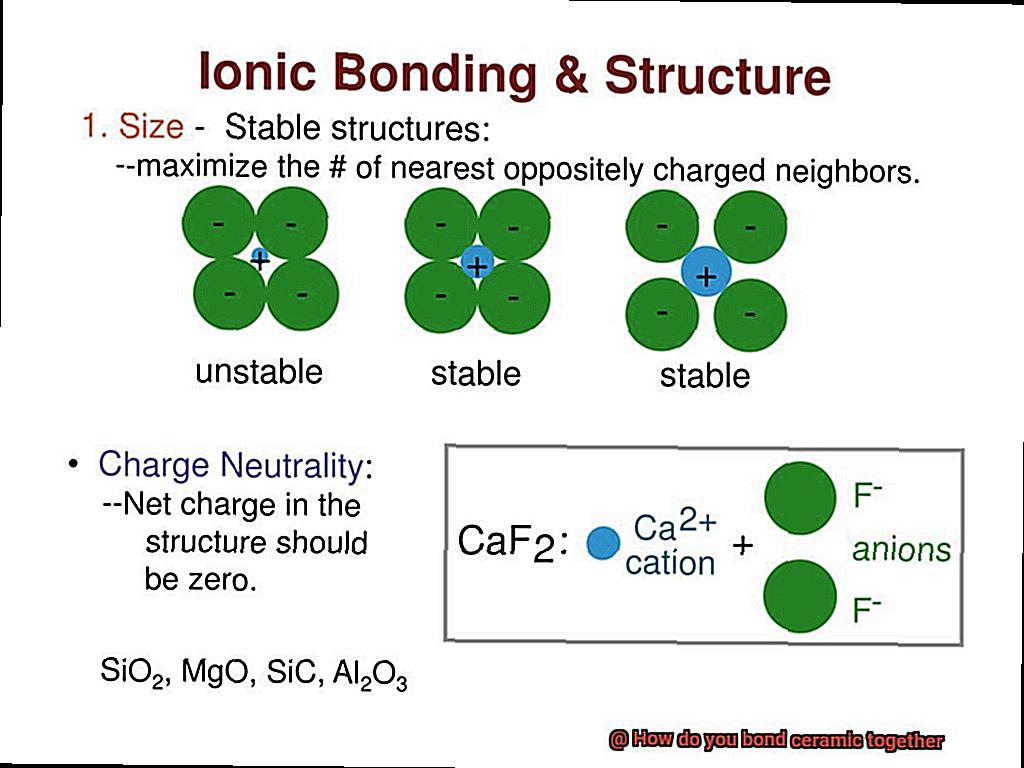
Epoxy Resin
In this blog post, we will delve into the wonders of epoxy resin as an adhesive for bonding ceramic materials together. Whether you’re a DIY enthusiast or a professional artist, understanding the properties of epoxy resin and its best application methods will empower you to create unbreakable connections in your ceramic masterpieces.
Properties of Epoxy Resin:
Epoxy resin, a two-component adhesive consisting of a resin and a hardener, possesses exceptional bonding strength when these components are mixed in the correct proportions. This chemical reaction activates the adhesive properties and ensures long-lasting connections between ceramic surfaces. Additionally, epoxy resin exhibits remarkable resistance to temperature fluctuations, moisture, and chemicals, making it highly suitable for ceramic bonding.
Types of Epoxy Resins:
The market offers various types of epoxy resins, each with its own specific characteristics. Some epoxy resins are designed for fast curing, while others provide extended working times. To determine the most suitable epoxy resin for your ceramic bonding needs, consult with experts at your local hardware store or conduct online research.
Application Methods:
To achieve optimal results when bonding ceramics with epoxy resin, follow these steps:
- Surface Preparation: Thoroughly clean and dry the ceramic surfaces to remove any contaminants that may hinder adhesion. Use a mild detergent or solvent to eliminate grease, dirt, or dust.
- Mixing: Carefully follow the manufacturer’s instructions to ensure the correct proportions of resin and hardener. Vigorously mix the components until they are uniformly blended.
- Application: Apply the mixed epoxy resin evenly onto both ceramic surfaces using a brush or spatula. Avoid applying too much resin, as excess can cause oozing when the surfaces are pressed together.
- Bonding: Firmly press the ceramic surfaces together, aligning them accurately. Hold them in place until the epoxy resin sets. The curing time may vary, so refer to the product instructions for guidance.
- Finishing Touches: Once the adhesive has fully cured, remove any excess resin by carefully sanding or scraping it away. The bonded ceramic pieces should now be securely connected.
Cyanoacrylate Glue (Super Glue)
Today, we’re diving into the world of ceramic bonding and discovering the magical powers of cyanoacrylate glue, also known as Super Glue. This fast-acting adhesive has become a staple in every artist’s toolbox, boasting its ability to create strong and durable bonds in just seconds. So, let’s explore the ins and outs of this superhero adhesive when it comes to bonding ceramic materials.
Composition:
Cyanoacrylate glue is composed of a unique cyanoacrylate monomer, a type of acrylic resin. This liquid adhesive cures upon exposure to moisture in the air. However, do exercise caution because this powerful glue can bond quickly to skin and other surfaces.
Surface Preparation:
To ensure an unbreakable bond, proper surface preparation is key. Before applying cyanoacrylate glue, make sure the ceramic surfaces are clean, dry, and free from any dirt or oil. A simple wipe with a clean cloth or using an appropriate cleaner should do the trick.
Application:
Now comes the exciting part – applying the Super Glue. Only a small amount is needed to achieve a strong bond between ceramic pieces. Remember, less is more. Applying excess glue may result in unsightly bonding lines. After applying the glue, press the ceramic pieces firmly together for a few seconds to allow for effective bonding.
Curing Time:
One of the remarkable features of cyanoacrylate glue is its fast curing time. The initial bond strength is achieved within seconds of application, but for maximum strength, allow 24 hours for complete curing. During this time, avoid subjecting the bonded ceramic to excessive stress.
Strength and Durability:
When used correctly, cyanoacrylate glue creates strong and durable bonds between ceramic materials. However, keep in mind that bond strength may vary depending on factors such as ceramic type, surface preparation, and application technique. To ensure optimal results, follow the manufacturer’s instructions and perform a bond strength test before putting the bonded ceramic under heavy loads or extreme conditions.
Limitations:
While cyanoacrylate glue is a versatile adhesive, it may not be suitable for all ceramic bonding applications. Porous ceramics or those with rough surfaces may not provide an ideal bonding surface for Super Glue. In such cases, consider using adhesives specially designed for porous materials.
Ceramic-Specific Bonding Agents
Ceramic-specific bonding agents are specially formulated adhesives that are designed to create strong and durable bonds between ceramic surfaces. These magical adhesives are like superheroes when it comes to creating unbreakable bonds between ceramic surfaces. They are specifically developed to adhere to the unique properties of ceramics, which can be challenging to bond due to their low porosity and smooth surfaces.
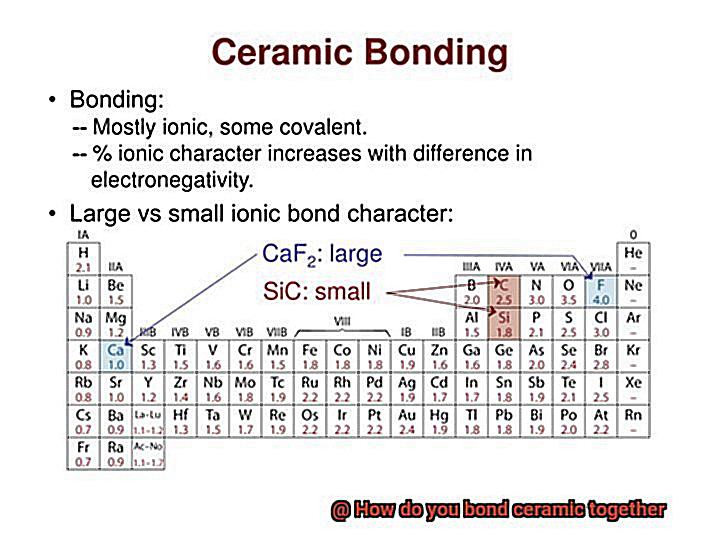
One common type of ceramic-specific bonding agent is epoxy resin. This dynamic duo consists of a resin and a hardener that work together to form a strong adhesive bond. Mix them in the right proportions, apply it to your ceramics, and watch the magic happen. Epoxy resins are known for their excellent adhesion properties and can bond different materials, including ceramics.
Next on our list is cyanoacrylate adhesive, also known as super glue. This fast-acting adhesive is perfect for those quick fixes or bonding small ceramic pieces. It forms a strong bond within seconds when it comes into contact with moisture. Just make sure your ceramic surfaces are clean and dry before applying this superhero glue.
Now, let’s talk about silane-based adhesives. These bonding agents are all about creating covalent bonds between the adhesive and the ceramic surface. The chemical reaction that takes place results in excellent adhesion and super-strong bonds. Silane-based adhesives are often used in industrial applications where high bond strength is crucial.
But wait, there’s more. We also have adhesive tapes or films specially formulated for ceramics. These pre-coated wonders are ready to go right out of the box. Simply apply them directly onto your ceramic surfaces, and voila. No mixing or curing required. They’re a convenient and easy solution for bonding ceramics.
Remember, my friends, proper surface preparation is key to achieving those unbreakable bonds. Make sure your ceramic surfaces are clean, dry, and free from any contaminants or oils that could mess with the bonding process. Some bonding agents might even require a little roughening up of the surfaces for better adhesion. Always read and follow the instructions provided by the manufacturer.
So, there you have it, a comprehensive overview of ceramic-specific bonding agents. Epoxy resins, cyanoacrylate adhesives, silane-based adhesives, and adhesive tapes or films are the superheroes that will save your ceramics from falling apart. Just remember to prep those surfaces properly and follow the instructions for a successful bonding experience.
Mechanical Fasteners for Bonding Ceramics
When it comes to bonding ceramics, mechanical fasteners offer a secure and reliable connection between components. In this article, we will explore the advantages and disadvantages of using mechanical fasteners for bonding ceramics, providing a comprehensive understanding of this bonding method.
Advantages of Mechanical Fasteners for Bonding Ceramics:
Ease of Assembly and Disassembly:
Mechanical fasteners allow for quick and easy joining of ceramic components without the need for curing or drying time. This makes them ideal for applications where future disassembly may be required, such as repairs or maintenance.
High Strength and Durability:
Bolts, nuts, threaded inserts, rivets, clamps, or brackets used as mechanical fasteners provide a strong and durable connection between ceramic pieces. These fasteners ensure that the components remain securely bonded even under various stresses and conditions, making them perfect for robust and long-lasting connections.
Resistance to Temperature and Chemical Exposure:
Mechanical fasteners made from materials like stainless steel or titanium offer excellent resistance to temperature extremes and chemical corrosion. This allows for reliable bonding in environments where adhesives or other bonding agents may fail.
Disadvantages of Mechanical Fasteners for Bonding Ceramics:
Aesthetic Limitations:
Mechanical fasteners may not be suitable for applications requiring a seamless or aesthetic appearance. The presence of bolts, nuts, or rivets may detract from the overall visual appeal of the ceramic assembly. In such cases, alternative bonding methods like adhesive tapes or films may be more appropriate.
Risk of Damage:
Improper installation or over-tightening of mechanical fasteners can lead to stress concentration, resulting in cracking or breaking of the ceramic material. Careful attention should be given to drilling holes at appropriate locations, using the correct size and type of fastener, and ensuring proper alignment and tightening of connections to minimize the risk of damage.
Factors that Affect the Success of Bonding Ceramics
Imagine being captivated by a delicate piece of ceramic art, its intricate design and fragile beauty captivating your attention. Now picture that same piece bonded securely to another ceramic surface, creating a seamless connection that enhances its strength and durability. The process of bonding ceramics may seem like magic, but it is actually a combination of careful preparation, thoughtful adhesive selection, and understanding the unique properties of ceramics. In this article, we will explore the factors that affect the success of bonding ceramics, with a focus on the role different adhesives play in achieving a strong bond.
Surface Preparation:
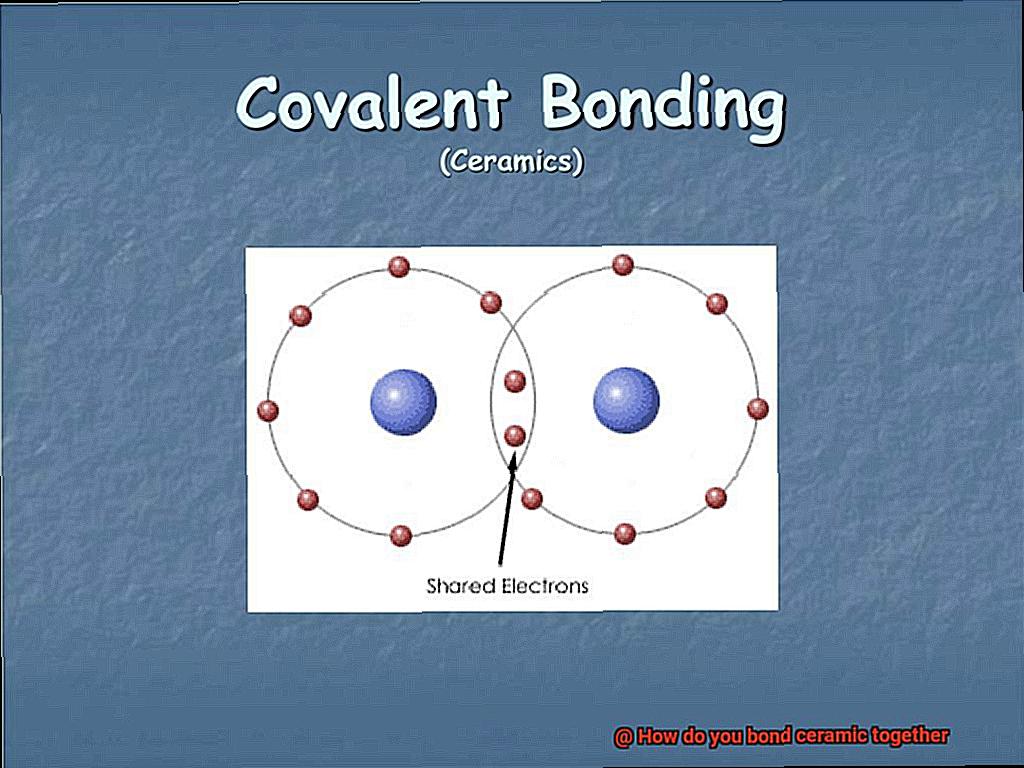
Before embarking on the journey of bonding ceramics, proper surface preparation is crucial. Cleaning the surfaces to remove any contaminants such as dirt, grease, or oils is essential. Solvents or cleaning agents specifically designed for ceramics can be used for this purpose. Additionally, roughening the surface through sanding or etching can improve adhesion by providing a larger surface area for the adhesive to bond to.
Adhesive Selection:
The choice of adhesive is perhaps one of the most critical factors in achieving a successful bond between ceramics. Epoxy, cyanoacrylate (super glue), polyurethane, and silicone-based adhesives are commonly used for bonding ceramics. Each type has its own advantages and disadvantages. Epoxy offers excellent strength and versatility, while cyanoacrylate provides rapid bonding and curing. Polyurethane adhesives offer flexibility and resistance to temperature fluctuations, while silicone-based adhesives provide excellent resistance to moisture and chemicals.
Compatibility:
Ensuring compatibility between the adhesive selected and both the ceramic materials being bonded and the intended application environment is vital. Some ceramics may have specific chemical compositions or surface treatments that require specialized adhesives for optimal bonding. Additionally, factors such as temperature, moisture, and exposure to chemicals or UV radiation should be considered to ensure the adhesive can withstand these conditions without compromising the bond.
Proper Mixing and Application:
For adhesives that require mixing before application, following the manufacturer’s instructions carefully is essential. Improper mixing ratios or incomplete mixing can result in weak bonds or curing issues. Similarly, applying the adhesive evenly and with adequate coverage on both surfaces is important for achieving a strong bond. Techniques such as brush application, spraying, or using precision dispensing tools may be employed depending on the adhesive type and application requirements.
Curing Time and Conditions:
Different adhesives have varying curing times and conditions. It is crucial to allow sufficient time for the adhesive to cure fully before subjecting the bonded ceramics to any stress or load. Factors such as temperature, humidity, and pressure can influence the curing process and should be controlled within the recommended range specified by the adhesive manufacturer. Failure to adhere to these guidelines can result in incomplete curing, weak bonds, or even adhesive failure.
Surface Preparation Before Applying Adhesives or Bonding Agents
The secret lies in the meticulous surface preparation before applying adhesives or bonding agents. Let’s delve into this crucial step and unravel the enchanting process of bonding ceramics together.
First and foremost, we must ensure that our ceramic surfaces are pristine. Any dirt, dust, or grease can interfere with the bonding process. Grab a trusty mild detergent or specialized ceramic cleaner and scrub those surfaces until they gleam. Rinse them with water and allow them to dry completely. We don’t want any lurking moisture when we embark on our magical journey.
Now that our surfaces are spotless, it’s time to add texture. Just as an artist adds depth and character to a painting with brushstrokes, roughening the ceramic surfaces provides more area for the adhesive or bonding agent to grip onto. Gently but firmly, use fine-grit sandpaper or a diamond abrasive pad to create a slight texture on the surface. We’re aiming for nothing short of magic here.
With our surfaces prepared, it’s time to introduce the star of the show – the primer or bonding agent. This special concoction is designed specifically for ceramic bonding and acts as our magical potion that enhances adhesion. Follow the manufacturer’s instructions precisely and apply the primer evenly over the entire bonding area. Remember, every inch counts in our spell.
After applying the primer, patience becomes paramount. Allow it to dry properly according to the manufacturer’s recommendations. Rushing this step could compromise the strength of our bond – and we certainly don’t want that. Let the magic work its wonders.
In some cases, porous ceramics may have imperfections or voids that require filling before applying the adhesive. Think of it as smoothing out any wrinkles in our magical fabric. Choose a filler material compatible with both the ceramics and the adhesive you plan to use. Ensure that the filler provides good adhesion and has similar properties to the ceramic material. We want to create a seamless connection, after all.
Before unveiling our grand masterpiece, it’s always wise to conduct a test bond on a small area of the ceramics. This ensures that we’ve chosen the right adhesive or bonding agent and that our surface preparation has been executed flawlessly. We don’t want any surprises once we’ve cast our final spell.
Application Techniques for Different Adhesives and Bonding Agents
In this comprehensive guide, we will explore the application techniques for different adhesives and bonding agents used to bond ceramics together.
Let’s start with everyone’s favorite adhesive superhero: epoxy. This trusty adhesive is known for its super strength and resistance to heat, chemicals, and moisture. To apply epoxy adhesive, begin by thoroughly cleaning the ceramic surfaces to ensure a strong bond. Mix the epoxy according to the instructions and apply a thin layer using either a brush or spatula. Press the two surfaces together firmly and hold them in place until the epoxy sets. For extra support, clamps can be your best friends during the curing process.
Next up is cyanoacrylate, also known as super glue. This fast-acting adhesive is perfect for those who can’t wait to see their ceramics back in one piece. Prepare the surfaces by giving them a good cleaning, then apply a small amount of super glue onto one of the ceramic surfaces. Be careful not to go overboard because excess glue can mess with your bond. Press the two surfaces together firmly and hold them for a few seconds until the adhesive sets. Just a heads up though, cyanoacrylate adhesives can bond skin instantly, so handle with care.
If you’re dealing with ceramics in high-temperature environments, silicone-based adhesives are your go-to choice. These bad boys can handle the heat like no other. Clean those ceramic surfaces like your life depends on it (well, maybe not that dramatic), then apply a thin layer of silicone-based adhesive using a brush or spatula. Press the surfaces together firmly and hold them in place until the adhesive sets. Keep in mind that silicone-based adhesives often require longer curing times, so patience is key here.
But wait, there’s more. If you’re looking for a bonding agent specifically designed for ceramics, look no further than ceramic cement. This magical substance offers excellent resistance to heat and chemicals. Mix the cement according to the instructions, apply it onto the ceramic surfaces, and press them together firmly. Hold your masterpiece in place until the cement sets. Just remember, ceramic cement usually takes longer to cure compared to other adhesives, so channel your inner Zen while waiting.
Tips for Choosing the Right Adhesive or Bonding Agent
Embarking on a ceramic project or repairing a broken ceramic item requires choosing the right adhesive or bonding agent for a strong and durable bond. In this blog post, we will provide helpful tips to guide you in selecting the perfect glue for your ceramic bonding needs.
Consider Adhesion:
When selecting an adhesive for ceramic bonding, it is crucial to choose one that offers excellent adhesion to ceramic surfaces. Epoxy resin is a popular choice as it chemically reacts with ceramics, providing a strong and reliable bond. It can withstand heat, chemicals, and moisture, making it versatile for various ceramic materials.
Strength Matters:
The strength of the bond needed depends on the application. Cyanoacrylate adhesive, also known as super glue, forms an instant and strong bond. However, for porous or uneven surfaces, epoxy or silicone-based adhesives may be better options as they provide superior strength and flexibility.
Durability is Key:
Consider the environmental conditions your bonded ceramics will face. If they will be exposed to water or UV radiation, choosing an adhesive that is water-resistant or UV-stable will ensure long-lasting durability. Always refer to the manufacturer’s recommendations for specific environmental requirements.
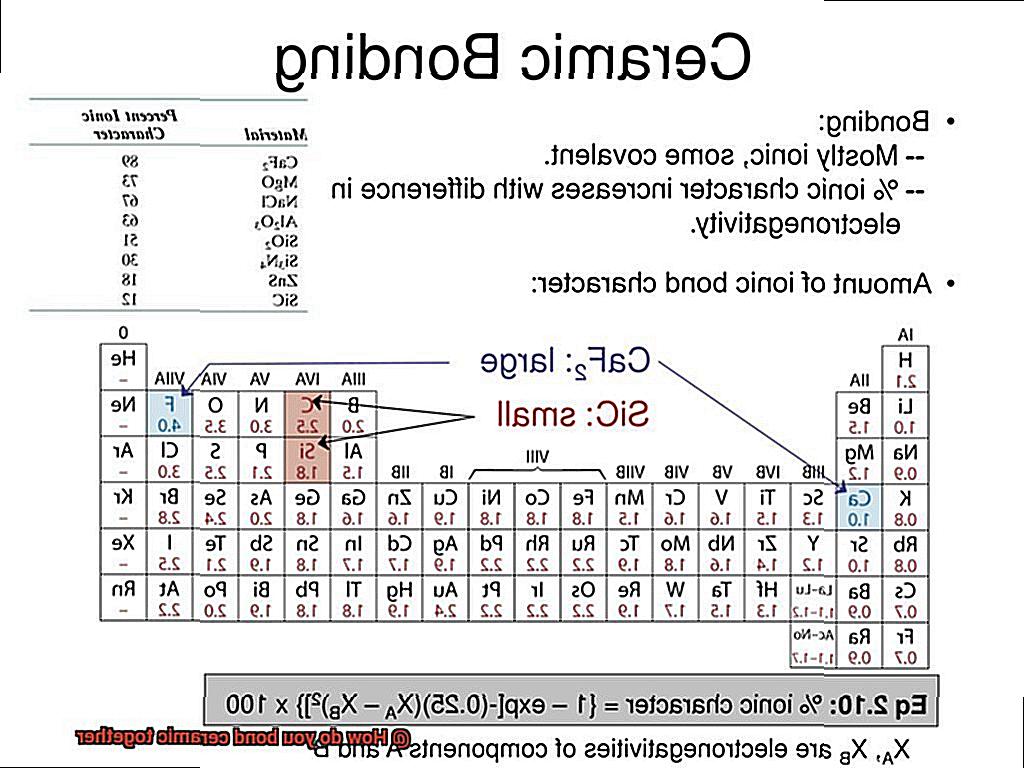
Surface Preparation is Essential:
To achieve a strong bond, proper surface preparation is essential. Thoroughly clean the ceramic surfaces with mild detergent or solvent to remove any dirt or grease. Additionally, sanding or roughening the surfaces can improve adhesion by providing more surface area for the adhesive to grip onto.
Consider Curing Time:
Different adhesives have varying curing times. Some offer quick setting times, while others require longer curing times for maximum strength. Consider the specific application and your time requirements when selecting an adhesive. It is important to allow sufficient curing time before subjecting the bonded ceramics to any stress or load.
Benefits of Using Mechanical Fasteners to Bond Ceramics
When it comes to bonding ceramics, the strength and durability of the bond are crucial. While adhesives have their place, mechanical fasteners take the lead in providing a secure and long-lasting bond that can withstand high-stress applications. In this article, we will delve into the benefits of using mechanical fasteners to bond ceramics together.
Unparalleled Strength and Durability:
- Mechanical fasteners like screws, bolts, and rivets offer a robust solution that can withstand significant forces.
- This ensures the longevity and reliability of ceramic components in demanding environments.
Easy Disassembly:
- Unlike adhesives, mechanical fasteners allow for easy disassembly without risking damage.
- Repairing, maintaining, or reconfiguring ceramic components becomes hassle-free.
- This facilitates cost-effective maintenance and upgrades.
Stress Distribution:
- Mechanical fasteners distribute stress evenly across the bonded area, reducing the risk of cracks or fractures.
- They enhance the structural integrity of bonded ceramics by spreading the load over a larger surface area.
Flexibility in Design and Assembly:
- Mechanical fasteners seamlessly integrate into various shapes and sizes of ceramic components.
- They provide design flexibility without complex or time-consuming processes.
Immediate Bond:
- Unlike adhesives that require curing or drying time, mechanical fasteners offer an immediate bond.
- This translates into faster production cycles, increased efficiency, and reduced downtime.
High-Temperature and Harsh Environment Resistance:
- Mechanical fasteners made from stainless steel or titanium can withstand high temperatures and harsh environments.
- This ensures the integrity of the bond and the longevity of the ceramics in industries like aerospace and automotive.
Cost-Effective Solution:
- Mechanical fasteners are widely available and relatively inexpensive.
- They eliminate additional equipment, training, or maintenance costs associated with adhesives.
- This makes them an affordable option for bonding ceramics without compromising on quality.
M2vtfNxHVv0″ >
Conclusion
When it comes to bonding ceramic together, there are several methods you can use.
One popular option is using an epoxy adhesive. This strong and durable adhesive forms a tight bond between the ceramic surfaces, ensuring a long-lasting connection.
Another method is using a cyanoacrylate adhesive, commonly known as super glue. This fast-acting adhesive works well for smaller ceramic pieces or quick repairs.
Additionally, you can also consider using a ceramic cement or a specialized ceramic glue specifically designed for bonding ceramics. These products provide excellent adhesion and are resistant to heat and moisture.
Remember to follow the instructions carefully and allow sufficient drying or curing time for the bond to fully set.

